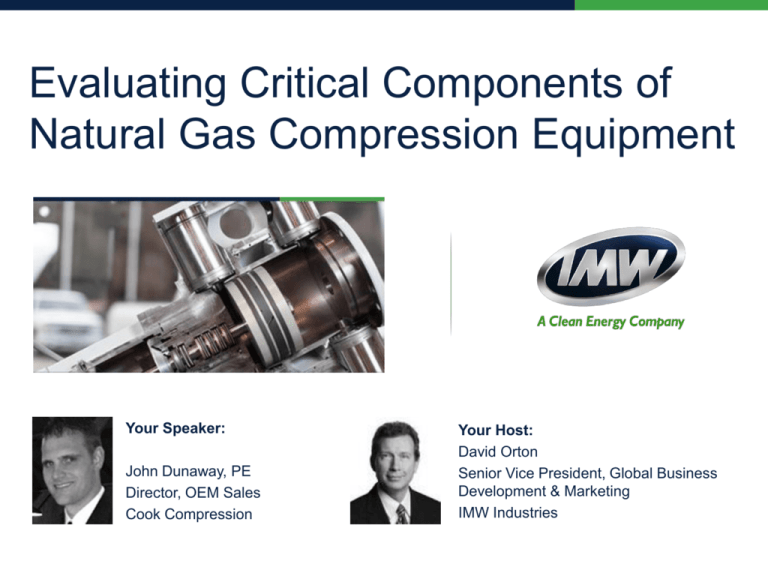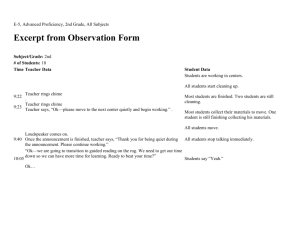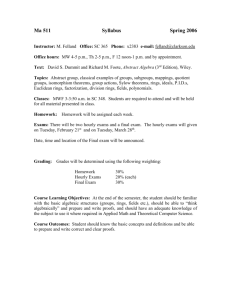webinar2014-02-20
advertisement

Evaluating Critical Components of Natural Gas Compression Equipment Your Speaker: John Dunaway, PE Director, OEM Sales Cook Compression Your Host: David Orton Senior Vice President, Global Business Development & Marketing IMW Industries About IMW IMW has been manufacturing industrial machinery since 1912, and has evolved to be a leading manufacturer of natural gas compression systems, serving all major markets Globally. Equipment is currently operating mid-east to North of the Arctic Circle. • • Quality Products & Leader in CNG Compression Non-Lubricated Compression for Clean CNG A variety of configurations for all applications A Clean Energy Company IMW operates as a wholly owned subsidiary of Clean Energy Fuels Corp. (NASDAQ: CLNE). Clean Energy is the largest provider of natural gas fuel for transportation in North America and a global leader in the expanding natural gas vehicle market. Clean Energy has operations in CNG and LNG vehicle fueling, construction and operation of CNG and LNG fueling stations, biomethane production, and compressor technology. Upcoming Webinars www.imw.ca/cng-webinars/ • • Free Monthly Webinars Documented CPD Credits More CPD Info or Board Room Attendance: webinars@imw.ca Join the Discussion! 6 Cook Compression Overview A worldwide leader in the component design, manufacturing, monitoring and repair of the full range of reciprocating compressors for the Natural Gas, Petrochemical, EOR and Industrial markets. • Division of Dover Corporation (NYSE: DOV) • Broad range of compressor valve, sealing & emissions control technologies. • Highly experienced engineering team with expertise across all compressor products and applications • Sophisticated Analyzers and Monitoring systems for predictive maintenance. 7 Course Overview • Definition and overview of critical compressor components • Describe the benefits and challenges surrounding nonlubricated CNG compression • Review Cook’s approach towards extending service life in non-lubricated CNG compressors • Review IMW’s standardization project and the benefit to the end customer 8 Defining Critical Components Piston Rings Pressure Packing Compressor Valves Evaluating Critical Components of Natural Gas Compression Rider Ring Wiper Packing 9 Packing Case Assembly Function: • Seals high pressure gas, prevents leakage from cylinder into frame or atmosphere • Packing Rings seal around the rod and against packing case cup • Sealed against cylinder with end gasket • Rod Rings are pressure actuated seals 10 Packing Case Assembly 11 How does it work? INSTRUMENTED PACKING CASE Monitors and record what is happening inside the packing case 12 Title Cylinder P Cup 2 P Cup 3 P Cup 4 P Cup 5 P Cup 6 P Packing Rings – How They Work PRESSURE HOLDS RINGS AGAINST ROD AND CUP FACE 13 SPRINGS HOLD RING TO ROD WHEN PRESSURE IS ZERO SIDE CLEARANCE ALLOWS RINGS TO “FLOAT” WITHIN CASE IF ROD MOVES LATERALLY ALL LEAK PATHS BLOCKED BY RING OVERLAP END CLEARANCE ALLOWS RINGS TO SELF ADJUST FOR WEAR 14 Standard Packing Rings • Most common ring is BTR style • The Radial and Butt-tangent, and rings are typically made from filledPTFE • Back Up rings are typically bronze or PEEK • Single-Acting, only seal in one direction • Must be installed with letters on face of rings facing pressure source BTR Ring 15 Wiper Rings • The purpose of wiper rings is to keep the crankcase oil in the crankcase by “wiping” it off the rod • Special edge geometry and high spring tension allow wiper ring to shear oil film off rod Crankcase side Oil Return Compressor side 16 Piston Rings and Riders Piston Rings • Piston rings stop or reduce the flow of gas between a piston and cylinder • Rider rings keep pistons from contacting the cylinder wall Rider Ring 17 Piston Rings and Riders • Typically Angle Cut, one piece or two piece • Seal joints and multi-piece rings used in higher stages to reduce blow-by • Side notches on riders prevent pressure loading under the ring • Filled PTFE or PEEK materials 18 Non-Lubricated CNG Compression Benefits Challenges • Oil carry-over into engine has adverse affect on performance. Removing oil from the compressor eliminates this concern. • Elimination of lubrication increases heat at sealing surface and can reduce life of rings if not properly accounted for • Reduced operational cost due to reduced oil consumption • Space constraints limit the available design envelope • Reduced capital and operating expenses from elimination of equipment required to deliver and handle compressor oil • High linear piston speed and high pressure at upper stages increases heat at sealing surfaces • Close-coupled frames create challenges for wiper seals 19 Non-Lube CNG Design Approach • A combination of upgraded materials and proper seal design is the key to extending service life • Material selection – must select a material that performs in the absence of oil • Product design – Heat and oil carryover are the enemies of ring life. We must select designs that minimize these factors. • Application Experience – Knowing which technologies best fit non-lube CNG applications 20 Material Selection • Challenge: Selecting wear materials to survive in the absence of oil Transfer Film • Transfer film is the key to nonlube material performance • Materials developed through extensive lab and field testing • Base Material Oil carryover washes away transfer film and accelerates wear Countersurface 21 Material Selection • Common materials for Non-lube CNG piston rings and rod rings include the following • • • • Carbon-filled PTFE Polyimide-filled PTFE Filled PEEK (high pressure) PTFE with proprietary fillers • Cleanliness is key when performing maintenance • All sealing surfaces should be cleaned with de-natured alcohol to remove all contaminants 22 Problem: Sources of Heat in Compressor Compression of Gas Friction of Rod Rings Friction of Piston Rings and Wear Bands IMW Standard Compressors • Cook and IMW are working on standard designs that will include best available technology for non-lube CNG compressors • Packing includes upgraded seal designs with carefully selected materials that optimize performance over a range of operating conditions • Piston rings will use joint designs and materials that minimize wear and blow-by • Designs configurations have been condensed to a minimal number of parts Key Takeaways • High service life can be achieved in non-lube CNG compressors when the proper considerations are taken • Heat and oil carryover are the enemies of service life, especially in nonlube applications • To maximize life, use the a combination of product designs and wear materials designed to reduce heat generation, limit oil carryover and minimize wear rates • Take proper cleanliness precautions during maintenance to promote material transfer film development • Standardized IMW compressors will utilize best available technology with a goal of achieving high service life, low lead times and high spares availability Questions? Contact Us! IMW Industries 43676 Progress Way Chilliwack, BC, Canada V2R 0C3 +1 604-795-9491 www.imw.ca Questions? sales@imw.ca webinars@imw.ca



